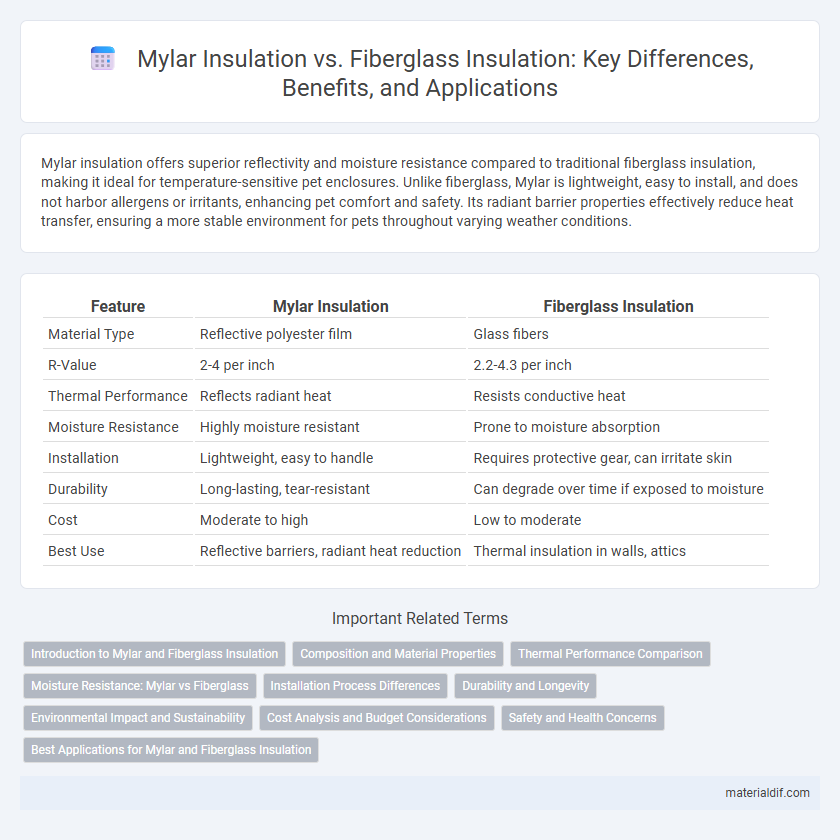Mylar insulation offers superior reflectivity and moisture resistance compared to traditional fiberglass insulation, making it ideal for temperature-sensitive pet enclosures. Unlike fiberglass, Mylar is lightweight, easy to install, and does not harbor allergens or irritants, enhancing pet comfort and safety. Its radiant barrier properties effectively reduce heat transfer, ensuring a more stable environment for pets throughout varying weather conditions.
Table of Comparison
| Feature | Mylar Insulation | Fiberglass Insulation |
|---|---|---|
| Material Type | Reflective polyester film | Glass fibers |
| R-Value | 2-4 per inch | 2.2-4.3 per inch |
| Thermal Performance | Reflects radiant heat | Resists conductive heat |
| Moisture Resistance | Highly moisture resistant | Prone to moisture absorption |
| Installation | Lightweight, easy to handle | Requires protective gear, can irritate skin |
| Durability | Long-lasting, tear-resistant | Can degrade over time if exposed to moisture |
| Cost | Moderate to high | Low to moderate |
| Best Use | Reflective barriers, radiant heat reduction | Thermal insulation in walls, attics |
Introduction to Mylar and Fiberglass Insulation
Mylar insulation consists of thin, reflective polyester film designed to reduce radiant heat transfer, making it highly effective in controlling temperature extremes. Fiberglass insulation, composed of fine glass fibers, functions primarily by trapping air to slow conductive and convective heat flow within walls and ceilings. Both materials serve distinct purposes in energy efficiency, with Mylar offering superior radiant barrier properties and fiberglass excelling at thermal resistance in building envelopes.
Composition and Material Properties
Mylar insulation is composed of biaxially-oriented polyethylene terephthalate (BoPET) film, offering high tensile strength, durability, and reflective properties that enhance thermal insulation by reflecting radiant heat. In contrast, fiberglass insulation consists of fine glass fibers designed to trap air and reduce conductive heat transfer, providing superior soundproofing but lower radiant heat reflection. Mylar's lightweight, moisture-resistant, and non-fibrous structure makes it ideal for radiant barriers, while fiberglass excels in thick batts or loose-fill applications for conductive and convective heat resistance.
Thermal Performance Comparison
Mylar insulation exhibits superior thermal performance compared to fiberglass insulation due to its reflective properties, which effectively reduce radiant heat transfer by up to 97%. Fiberglass relies primarily on trapping air within its fibers to slow conductive heat flow but has lower resistance to radiant heat, resulting in an average R-value of 2.2 to 4.3 per inch. The combination of Mylar's reflective surface and durable polyester film structure provides enhanced energy efficiency, especially in applications requiring radiant heat barriers.
Moisture Resistance: Mylar vs Fiberglass
Mylar insulation offers superior moisture resistance compared to fiberglass insulation due to its reflective polyester film structure, which acts as a vapor barrier preventing water penetration. Fiberglass insulation is more porous and can absorb moisture, leading to reduced thermal efficiency and potential mold growth. Choosing Mylar insulation is advantageous in environments prone to humidity and condensation, ensuring long-term durability and performance.
Installation Process Differences
Mylar insulation installs faster due to its lightweight, reflective foil design that can be stapled directly onto wall studs or roof rafters, minimizing labor time. Fiberglass insulation requires careful handling to avoid skin irritation and is typically fitted between studs, requiring more precise cutting and securing to ensure proper coverage. Mylar's rigid, non-fibrous material simplifies installation and cleanup, whereas fiberglass demands protective gear and disposal precautions to manage airborne particles.
Durability and Longevity
Mylar insulation offers superior durability compared to fiberglass insulation due to its resistance to moisture, mold, and degradation over time, making it ideal for long-term applications. Fiberglass insulation tends to lose its insulating properties when exposed to moisture and physical damage, reducing its longevity. Mylar's reflective surface maintains thermal efficiency for decades, outperforming fiberglass that often requires replacement or maintenance within 15 to 20 years.
Environmental Impact and Sustainability
Mylar insulation offers a reflective barrier that reduces heat transfer and lowers energy consumption, contributing to improved sustainability compared to traditional fiberglass insulation, which relies on non-renewable resources and generates more waste. Unlike fiberglass, Mylar is often recyclable and contains fewer harmful chemicals, minimizing environmental hazards during manufacturing and disposal. Choosing Mylar insulation supports eco-friendly building practices by promoting energy efficiency and reducing landfill impact.
Cost Analysis and Budget Considerations
Mylar insulation typically costs more upfront than fiberglass insulation but offers higher durability and energy efficiency, potentially reducing long-term energy expenses. Fiberglass insulation is more budget-friendly initially, making it suitable for cost-conscious projects, but it may require more frequent replacement and maintenance. Evaluating the total lifecycle cost, including installation, energy savings, and maintenance, is crucial for informed budget decisions between Mylar and fiberglass insulation.
Safety and Health Concerns
Mylar insulation offers superior safety over fiberglass insulation due to its non-toxic, hypoallergenic properties, eliminating respiratory irritation risks common with fiberglass fibers. Unlike fiberglass, Mylar does not release airborne particles or irritants, reducing the likelihood of skin, eye, and lung discomfort during installation and use. Its reflective surface also minimizes mold and mildew growth, enhancing indoor air quality and long-term health safety.
Best Applications for Mylar and Fiberglass Insulation
Mylar insulation excels in reflective applications where radiant heat barriers are essential, such as in attics, walls, and radiant floor heating systems, due to its high reflectivity and moisture resistance. Fiberglass insulation is ideal for thermal and soundproofing purposes in walls, ceilings, and HVAC ducts, offering effective heat retention and noise reduction with its dense fibrous composition. Choosing between Mylar and fiberglass insulation depends on climate conditions and specific energy efficiency goals, where Mylar outperforms in hot, sunny environments and fiberglass excels in colder climates requiring thermal mass.
Mylar Insulation vs Fiberglass Insulation Infographic

 materialdif.com
materialdif.com